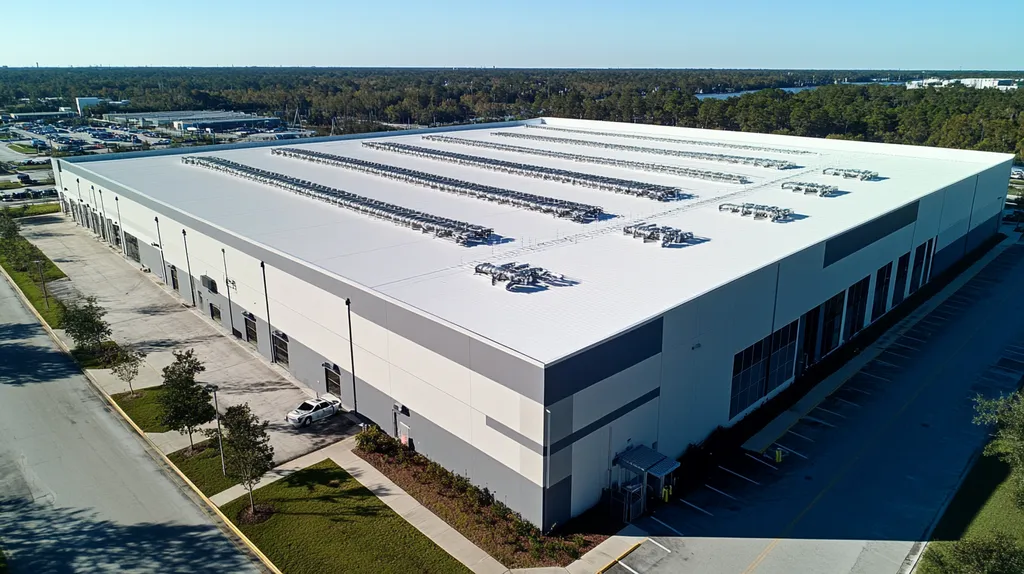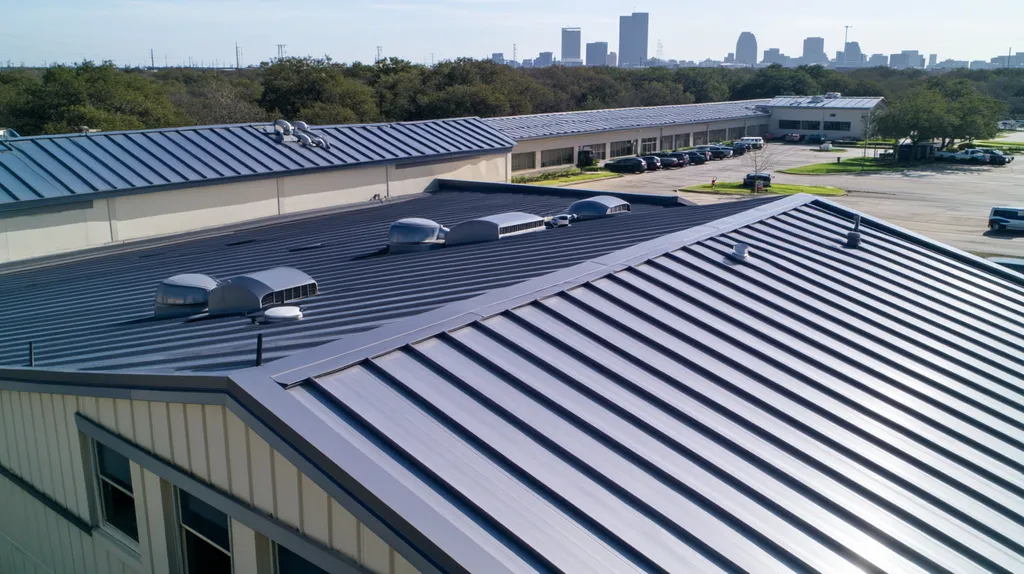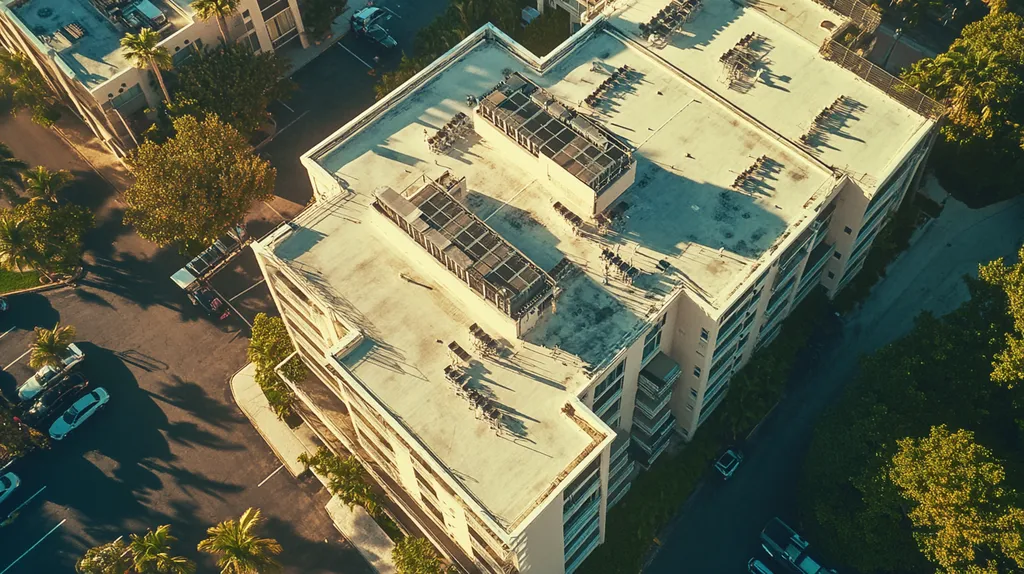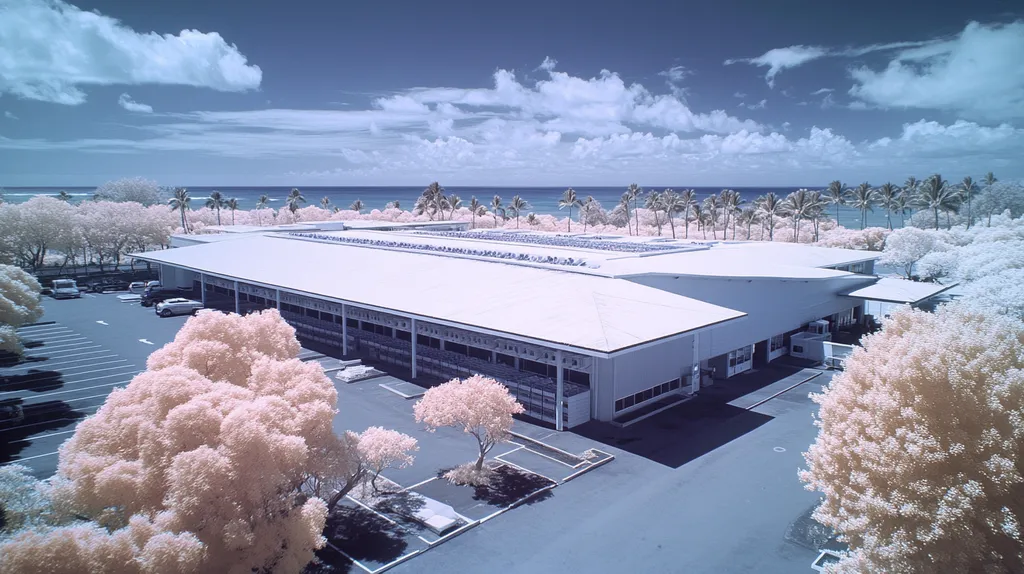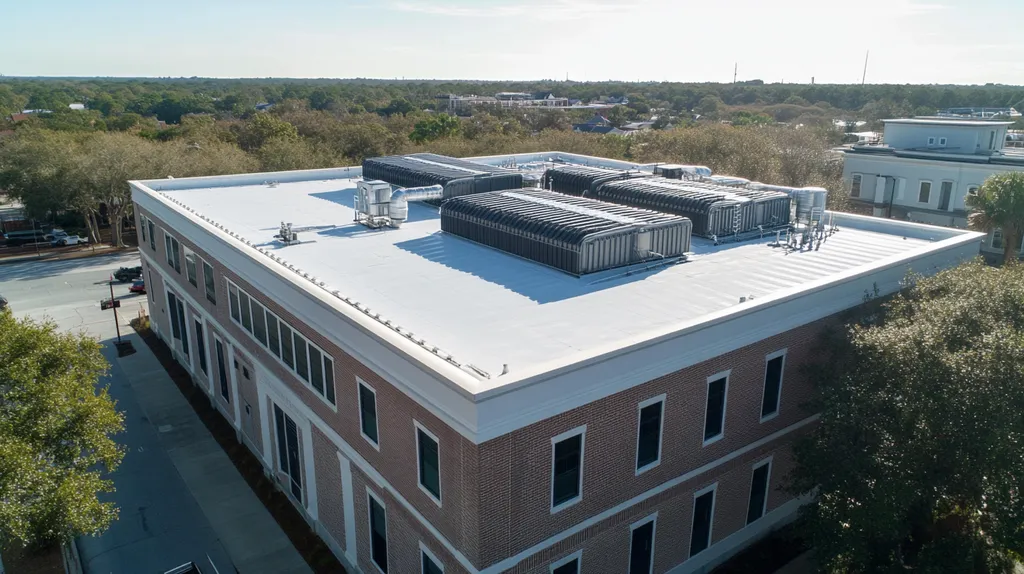Surface preparation errors account for over 80% of premature roof coating failures in commercial buildings, resulting in millions of dollars in unnecessary repairs annually.
Despite clear industry standards and manufacturer guidelines, persistent myths about proper preparation continue driving costly mistakes that compromise both coating performance and building protection.
This analysis examines common misconceptions about surface preparation, their practical implications, and evidence-based solutions that ensure successful coating applications in commercial roofing projects.
SECTION 1: COMMON MISCONCEPTIONS
Surface preparation errors account for over 80% of premature roof coating failures in commercial buildings. These failures not only compromise building protection but also result in millions of dollars in unnecessary repairs annually. The roofing industry continues to battle persistent myths about proper preparation techniques, leading to costly mistakes that could be avoided with correct information and procedures.
Myth: Surface Cleaning Alone Ensures Adhesion
Basic cleaning represents only the first step in proper surface preparation. While removing visible dirt and debris is essential, microscopic contaminants and surface irregularities can significantly impact coating adhesion.
Surface profile testing, moisture content measurement, and pH balance evaluation are equally critical components that determine coating success. These factors directly influence the molecular bond between coating and substrate.
Modern coating systems require specific surface tension levels and mechanical grip characteristics to achieve maximum adhesion. Simple pressure washing or sweeping cannot address these fundamental requirements.
Proper preparation must include detailed surface assessment, appropriate mechanical treatments, and verification of substrate compatibility before coating application begins.
Misbelief: All Roof Coatings Are Universal Solutions
Most coating failures stem from mismatched products and substrates, particularly with water-dispersed acrylic polymer systems commonly used on asphalt shingle roofs. These specialized formulations require specific conditions and substrates to perform as intended. (source: Professional Roofing magazine)
Chemical compatibility between coating and substrate determines both immediate adhesion and long-term performance. Different roofing materials require specifically engineered coating solutions.
Environmental conditions, including temperature ranges, humidity levels, and UV exposure, further limit coating compatibility. What works in one climate zone may fail in another.
Building use, maintenance requirements, and local regulations also influence coating selection. These factors must align with the coating’s performance characteristics.
Fallacy: Primer Application Is Optional
Primer serves as more than just an intermediate layer – it fundamentally changes how the topcoat bonds with the substrate. Skipping this critical step compromises the entire coating system’s integrity.
Modern primers contain specialized binding agents that create chemical bridges between dissimilar materials. This molecular interaction ensures proper adhesion across the entire surface area.
Surface porosity variations and existing coating remnants require primer to establish uniform absorption rates. Without primer, coating thickness becomes inconsistent, leading to premature failure.
Temperature fluctuations and building movement stress coating adhesion over time. Proper primer application provides the flexibility and grip strength needed to maintain coating integrity under these conditions.
SECTION 2: PRACTICAL IMPLICATIONS
Surface preparation decisions have immediate and long-lasting consequences for commercial roofing systems. Industry data shows that improper preparation leads to coating failures within 2-3 years, while properly prepared surfaces can extend coating life beyond 15 years. These failures result in increased maintenance costs, accelerated deterioration of building materials, and potential disruption to business operations.
Impact of Incomplete Surface Preparation on Coating Performance
Surface preparation is one of the most critical steps in ensuring successful roof coating installation. Inadequate preparation directly impacts coating adhesion, durability, and long-term performance across the entire roofing system. (source: Waterproof Magazine)
When preparation steps are shortened or skipped, coating systems typically fail through delamination, blistering, or peeling. These failures often begin at weak points where contaminants or moisture remained trapped beneath the coating.
Microscopic surface irregularities that go unaddressed create paths for moisture infiltration. This trapped moisture eventually leads to coating separation and substrate deterioration.
The cost to remove failed coatings and properly prepare surfaces typically exceeds the initial investment by 200-300%. This excludes additional expenses from potential water damage to building interiors.
Consequences of Ignoring Substrate Repairs Before Coating
Existing substrate damage creates compound problems when left unrepaired before coating application. Cracks, separations, and deteriorated areas continue to worsen beneath even properly applied coatings.
Water infiltration through unrepaired areas accelerates substrate deterioration. This creates expanding zones of coating failure as moisture spreads beneath the surface.
Structural components exposed to ongoing moisture through unrepaired substrates face premature aging. Metal fasteners, deck materials, and insulation systems all become compromised.
The combination of coating failure and continued substrate deterioration often necessitates complete roof replacement years before the expected service life.
Role of Environmental Conditions During Surface Prep and Application
Temperature, humidity, and dew point measurements critically impact both preparation and coating cure times. Conditions outside manufacturer specifications can prevent proper adhesion regardless of preparation quality.
Morning dew and evening temperature drops create condensation that interferes with coating adhesion. These daily cycles must be factored into preparation and application scheduling.
Wind-borne contaminants can compromise freshly prepared surfaces within hours. This requires careful coordination between preparation completion and coating application.
Seasonal weather patterns influence preparation method selection and timing. Winter preparations often require different approaches than summer work to achieve equivalent results.
SECTION 3: COST OF MISINFORMATION
Surface preparation misinformation creates a cascade of costly consequences for commercial property owners. Industry data reveals that inadequate preparation leads to coating failures within the first 24 months, resulting in repair costs averaging 3-4 times the original installation price. Beyond direct repair expenses, these failures trigger a chain reaction of accelerated deterioration, business disruption, and premature roof replacement that impacts both operational budgets and asset value.
Financial Risks of Skipping Proper Surface Preparation
Surface preparation is one of the most critical steps in ensuring successful roof coating installation. Removing damaged materials, ensuring proper flashing installation, and following manufacturer specifications directly impact both immediate and long-term performance. (source: Waterproof Magazine)
Warranty coverage becomes void when preparation standards are not met, leaving building owners fully exposed to repair costs that often exceed $100,000 for larger commercial facilities.
Emergency repairs triggered by coating failures typically cost 300-400% more than planned maintenance, while also creating unplanned business disruptions and potential inventory damage.
The compounding effect of these expenses often forces premature roof replacement, eliminating any perceived savings from reduced preparation work.
Increased Maintenance and Early Roof Failures from Poor Prep
Inadequate surface preparation creates a pattern of escalating maintenance needs that strain facility budgets. What begins as minor adhesion issues often develops into systematic coating failure requiring complete removal and reapplication.
Building maintenance teams must divert resources to manage recurring leaks and damage, creating a ripple effect that impacts other preventive maintenance programs.
The frequency of repair visits increases exponentially as coating failures spread, with each intervention requiring more extensive work to address both symptoms and underlying causes.
Early roof coating failure often accelerates the deterioration of other building systems, including insulation, deck materials, and interior finishes.
Hidden Costs Linked to Inadequate Substrate Assessment
Moisture trapped within existing roof assemblies remains the leading cause of coating system failures. Without proper assessment, this invisible threat continues to damage structural components even after coating application.
Infrared scanning and core sampling costs average less than 2% of total project expenses, yet skipping these critical assessments leads to failures costing 40-50% of the original installation.
Contaminated or deteriorated substrates that go undetected create chemical incompatibilities that prevent proper coating adhesion across large sections of the roof.
The cost to remove failed coatings, properly assess substrates, and reapply appropriate systems typically exceeds initial project budgets by 200-300%.
SECTION 4: REALITY CHECK
Surface preparation represents the foundation of successful commercial roof coating applications, yet misconceptions continue driving costly mistakes. Recent industry data shows that inadequate surface preparation reduces coating lifespans by 60-80% compared to properly prepared surfaces. With commercial roof coating failures costing building owners millions annually in premature replacements and repairs, understanding reality-based preparation requirements has never been more critical.
Industry Standards and Manufacturer Guidelines for Surface Prep
Roof coatings must be applied to surfaces that are free of contaminants and properly prepared to ensure longevity. Surface cleanliness, profile characteristics, and moisture content all play critical roles in coating adhesion and performance. (source: American WeatherStar)
ASTM and NRCA standards establish specific preparation requirements for different roofing substrates. These include minimum adhesion values, acceptable moisture levels, and surface profile measurements that must be verified before coating application.
Manufacturer guidelines typically require detailed documentation of surface preparation steps, environmental conditions, and quality control testing. This documentation becomes essential for warranty compliance and validation.
Quality control checkpoints must be integrated throughout the preparation process. These verify that each preparation phase meets required standards before proceeding to subsequent steps.
Importance of Thorough Roof Inspections Prior to Coating
Professional roof inspections identify critical issues that could compromise coating performance. These include structural deficiencies, moisture infiltration, and existing material degradation that must be addressed before coating application.
Core sampling and moisture scanning reveal subsurface conditions invisible to visual inspection. This data prevents coating application over compromised substrates that would lead to premature failure.
Detailed inspection reports document existing conditions and necessary repairs. This creates accountability and ensures all stakeholders understand required preparation scope.
Regular inspection programs help track surface degradation patterns and optimal coating timing. This proactive approach prevents emergency coating applications under compromised conditions.
Compatibility Considerations Between Roof Material and Coating Types
Chemical compatibility between existing roof materials and new coatings determines long-term adhesion success. Different substrates require specific coating formulations engineered for their unique surface characteristics.
Surface tension and porosity variations across different roofing materials impact coating wet-out and curing. These factors must align with coating properties to achieve proper adhesion.
Environmental exposure conditions further influence coating compatibility requirements. UV resistance, temperature flexibility, and moisture permeability all factor into appropriate coating selection.
Testing programs verify coating compatibility with existing materials before full-scale application. This prevents systemic failures from mismatched coating selections.
SECTION 5: EVIDENCE-BASED ALTERNATIVES
Commercial roof coating failures cost property owners millions annually, with over 80% of premature failures traced to improper surface preparation. Recent industry analysis reveals that buildings with inadequate preparation require complete coating replacement within 2-3 years, while properly prepared surfaces maintain protection for 15+ years. Understanding and implementing evidence-based preparation methods represents the difference between long-term protection and recurring expenses that compound over time.
Comprehensive Surface Cleaning and Repair Protocols
Surface preparation is one of the most important steps for successful roof coating installation. This includes removing and replacing damaged materials, ensuring proper flashing installation, and following all manufacturer-specified surface treatments. (source: Waterproof Magazine)
Mechanical cleaning methods must address both visible contamination and microscopic surface irregularities. High-pressure washing alone cannot achieve the surface profile required for optimal coating adhesion.
Surface repairs must extend beyond visible damage to address underlying moisture infiltration and substrate deterioration. Infrared scanning helps identify hidden wet areas that would compromise coating performance.
Quality control testing between preparation phases ensures each step meets specification requirements. This includes adhesion testing, moisture measurement, and surface profile verification.
Use of Primers and Adhesion Promoters Supported by Research
Chemical primers create molecular bonds between substrates and coating systems that mechanical cleaning alone cannot achieve. These specialized formulations address surface chemistry variations that impact coating adhesion.
Different substrate materials require specific primer formulations engineered for their unique surface characteristics. Using incorrect primers can create chemical incompatibilities that prevent proper coating adhesion.
Environmental conditions impact primer selection and application timing. Temperature, humidity, and dew point measurements must align with manufacturer specifications throughout the priming process.
Adhesion testing after primer application verifies proper chemical interaction before coating application begins. This prevents systemic failures from incompatible primer selection.
Selecting Coatings Tailored to Specific Roof Systems and Conditions
Coating selection must account for existing roof materials, environmental exposure, and building use requirements. Different substrates demand specific coating formulations engineered for their unique surface characteristics.
UV exposure, temperature fluctuations, and precipitation patterns influence coating performance requirements. Regional climate conditions often determine which coating systems will provide optimal protection.
Building operations impact coating selection through factors like roof access frequency, equipment mounting requirements, and chemical exposure risks. These operational demands must align with coating performance characteristics.
Regular coating assessment programs help track performance patterns and optimize future coating selections. This data-driven approach prevents recurring failures from mismatched coating applications.
SECTION 6: TEST AND VERIFY
Quality control testing represents the critical difference between coating success and failure in commercial roofing. Industry data shows that systematic testing protocols reduce coating failures by up to 85% compared to visual inspection alone. With replacement costs averaging $12-15 per square foot, implementing proper testing at each preparation phase protects both the coating investment and the underlying building structure.
Methods to Assess Surface Cleanliness and Roughness Before Coating
Surface preparation requires specific testing protocols to ensure coating adhesion success. Removing and replacing damaged materials, verifying flashing installation, and following manufacturer-specified surface treatments establish the foundation for long-term performance. (source: Castagra Products, Inc.)
Standard surface cleanliness tests include white cloth wipe tests and water break evaluations. These methods identify microscopic contaminants that compromise coating adhesion yet remain invisible to visual inspection.
Quantitative surface profile measurements using comparators and depth gauges verify appropriate mechanical texture. Different coating systems require specific profile ranges to achieve optimal adhesion characteristics.
Environmental monitoring throughout preparation ensures conditions meet manufacturer requirements. Temperature, humidity, and dew point readings must be documented at regular intervals.
Field Adhesion Testing Procedures for Quality Assurance
Pull-off adhesion testing provides measurable data on coating bond strength. This standardized method identifies weak points before they develop into systemic failures.
Cross-hatch testing evaluates coating flexibility and substrate bonding across representative roof areas. Results guide adjustments to preparation methods before full application proceeds.
Wet film thickness measurements during application ensure proper material coverage. Maintaining consistent coating thickness prevents premature wear and adhesion failure.
Documentation of all test results creates an audit trail for warranty compliance. This data also guides future maintenance planning and coating selection.
Post-Application Monitoring Techniques to Ensure Coating Integrity
Regular coating inspections using standardized assessment protocols identify early warning signs of potential failure. This proactive approach prevents minor issues from developing into major repairs.
Infrared scanning detects subsurface moisture accumulation that threatens coating adhesion. Early detection allows targeted repairs before widespread delamination occurs.
Core sampling at strategic locations verifies long-term coating performance. Analysis of these samples reveals degradation patterns and guides maintenance timing.
Digital documentation of inspection findings creates trending data for predictive maintenance. This information optimizes repair scheduling and extends coating service life.
The Bottom Line
Surface preparation errors account for over 80% of premature coating failures, costing commercial property owners millions in avoidable repairs and replacements annually.
Proper surface preparation requires comprehensive testing, appropriate primers, and verified cleaning protocols that address both visible and microscopic contamination.
The financial impact of preparation shortcuts typically amounts to 300-400% of the original coating investment when factoring in removal, reapplication, and repair costs.
Success depends on following manufacturer guidelines, conducting thorough substrate assessment, and implementing systematic quality control measures throughout the preparation process.
Moving forward, commercial property owners must prioritize evidence-based surface preparation to protect their coating investments and ensure long-term roof system integrity.
FREQUENTLY ASKED QUESTIONS
Q. What are common misconceptions about commercial roof surface preparation?
A. Many believe cleaning is sufficient for adhesion, ignoring the need for detailed assessments. Various factors like surface tension, moisture, and substrate compatibility affect the effectiveness of coatings. Neglecting these elements can lead to premature failures and costly repairs down the line.
Q. How does surface preparation impact the lifespan of commercial roofs?
A. Effective surface preparation significantly extends the lifespan of commercial roof coatings. Well-prepared surfaces can maintain their protective qualities for over 15 years, while inadequate preparation often leads to failures within 2-3 years. This discrepancy results in higher long-term costs for building owners.
Q. What are the financial risks associated with poor commercial roof preparation?
A. Skipping proper surface preparation can lead to significant financial burdens, including voided warranties and increased repair costs. Property owners frequently face expenses averaging 3-4 times the original installation price for emergency repairs caused by failed coatings. This cascading effect can destabilize operational budgets.
Q. Why are primers critical in commercial roof coating applications?
A. Primers are essential as they enhance adhesion between the coating and substrate. They create chemical bonds that are crucial for maintaining the integrity of the coating system. Skipping primer application can lead to uneven coating thickness and increased likelihood of failure.
Q. How do environmental conditions affect surface preparation for industrial roofs?
A. Environmental conditions, such as temperature and humidity, are critical for successful preparation and application. These factors can directly affect adhesion and curing times. Scheduling a coating application during optimal weather conditions ensures better bond strength and prevents issues like condensation, which can compromise adhesion.
Q. What testing procedures improve quality control in commercial roof coatings?
A. Implementing standardized testing procedures such as adhesion tests, moisture assessments, and surface profile evaluations increases quality control. These tests identify potential issues before coating application and significantly reduce failure rates. Documenting test results creates accountability and aids in compliance with warranty requirements.
Q. How can choosing the right coating provide better results for commercial roofs?
A. Selecting coatings tailored to specific roof systems and environmental conditions enhances protection. Different substrates have unique characteristics that require specific formulations for optimal adhesion and longevity. Evaluating factors like UV exposure and temperature fluctuations ensures the coating can withstand the building’s operational demands and extends its service life.

